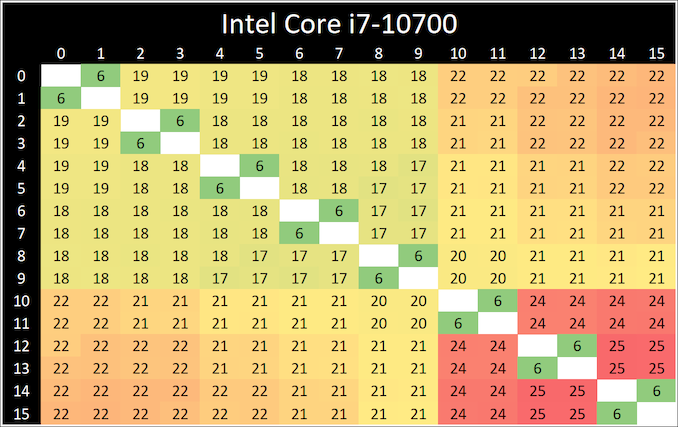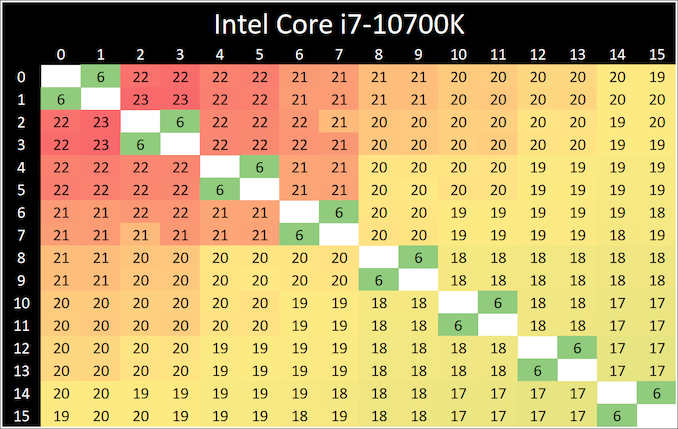Intel Core i7-10700 vs Core i7-10700K Review: Is 65W Comet Lake an Option?
by Dr. Ian Cutress on January 21, 2021 10:30 AM EST- Posted in
- CPUs
- Intel
- Core i7
- Z490
- 10th Gen Core
- Comet Lake
- i7-10700K
- i7-10700
CPU Tests: Microbenchmarks
Core-to-Core Latency
As the core count of modern CPUs is growing, we are reaching a time when the time to access each core from a different core is no longer a constant. Even before the advent of heterogeneous SoC designs, processors built on large rings or meshes can have different latencies to access the nearest core compared to the furthest core. This rings true especially in multi-socket server environments.
But modern CPUs, even desktop and consumer CPUs, can have variable access latency to get to another core. For example, in the first generation Threadripper CPUs, we had four chips on the package, each with 8 threads, and each with a different core-to-core latency depending on if it was on-die or off-die. This gets more complex with products like Lakefield, which has two different communication buses depending on which core is talking to which.
If you are a regular reader of AnandTech’s CPU reviews, you will recognize our Core-to-Core latency test. It’s a great way to show exactly how groups of cores are laid out on the silicon. This is a custom in-house test built by Andrei, and we know there are competing tests out there, but we feel ours is the most accurate to how quick an access between two cores can happen.
When we first reviewed the 10-core Comet Lake processors, we noticed that a core (or two) seemed to take slightly longer to ping/pong than the others. These two parts are both derived from the 10-core silicon but with two cores disabled, and we still see a pattern of some cores having additional latency. The ring on the 8-core parts still acts like a 10-core ring, but it all depends on which cores were disabled.
Frequency Ramping
Both AMD and Intel over the past few years have introduced features to their processors that speed up the time from when a CPU moves from idle into a high powered state. The effect of this means that users can get peak performance quicker, but the biggest knock-on effect for this is with battery life in mobile devices, especially if a system can turbo up quick and turbo down quick, ensuring that it stays in the lowest and most efficient power state for as long as possible.
Intel’s technology is called SpeedShift, although SpeedShift was not enabled until Skylake.
One of the issues though with this technology is that sometimes the adjustments in frequency can be so fast, software cannot detect them. If the frequency is changing on the order of microseconds, but your software is only probing frequency in milliseconds (or seconds), then quick changes will be missed. Not only that, as an observer probing the frequency, you could be affecting the actual turbo performance. When the CPU is changing frequency, it essentially has to pause all compute while it aligns the frequency rate of the whole core.
We wrote an extensive review analysis piece on this, called ‘Reaching for Turbo: Aligning Perception with AMD’s Frequency Metrics’, due to an issue where users were not observing the peak turbo speeds for AMD’s processors.
We got around the issue by making the frequency probing the workload causing the turbo. The software is able to detect frequency adjustments on a microsecond scale, so we can see how well a system can get to those boost frequencies. Our Frequency Ramp tool has already been in use in a number of reviews.
Both processors ramp from idle to full turbo in about six milliseconds, well within a single frame of standard gaming.













210 Comments
View All Comments
bji - Tuesday, January 26, 2021 - link
Well I guess it's a difference of opinion about what "general availability" means. If most people who are not within direct driving distance of a MicroCenter are having a hard time finding these chips, then I would call that not "general availability". I did admit that I overstated the low number of people who are in driving distance to a MicroCenter, but I still contend that it's a low number relative to the total number of people who want to buy these chips. We could start arguing now about who is TRULY within reasonable driving distance of a MicroCenter -- if you have to drive 1 hour to get the chip, is it really still generally available? If your time is even worth $15/hr minimum wage, that's adding a significant cost in the dollar value of your time to the cost.But I really don't want to argue about it any more. I still think these chips are not generally available and posting an article that compares one to to another when one or both are not easy to get for the vast majority of people, is disingenuous as it presents choices that do not practically exist. If you disagree, then that's fine.
Spunjji - Wednesday, January 27, 2021 - link
It's not a difference of opinion, it's a difference in perspective. I don't even care about MicroCenter because I'm not from the USA. These chips have "general availability" in the EU and UK at the very least, so I appreciate the comparison - as will many other peopleThis article will be around longer than demand continues to outstrip supply in the USA, and maybe even long enough to see $15 an hour become the minimum wage there. 👍
brucethemoose - Thursday, January 21, 2021 - link
Maybe they'll go the route of GPUs and just stop advertising TDPs entirely?This whole system works because most desktop users don't seem to care about TDP or power consumption. Performance at the absolute extreme end of the frequency/voltage curve is all that seems to matter.
Mr_Spock - Thursday, January 21, 2021 - link
I appreciate the testing, showing that with most other things 'equal', there is effectively little difference between the 10700/K.Would you consider running any tests with a 65W-class cooler to demonstrate exactly how performance is damaged by only matching the TDP on the box?
Having the full-bore tests for 10700 is quite useful if you can't find the K at a decent price, but if we're talking about quoted TDP 'limits', let's try limiting to that heat dissipation and see how quickly it flops.
I built a few Haswell systems back in the day, and whoo boy, were those stock coolers ineffective if you got any decent chip under it.
DominionSeraph - Thursday, January 21, 2021 - link
Eh? The stock cooler on the 4770 was fine. They only pulled 50W. I have no idea what you mean by "any decent chip under it" since there was only the 4770 and 4790 at the top and their wattage was about the same. (my 4790 was undervolted a tad and was 50W)Mr_Spock - Thursday, January 21, 2021 - link
Running prime95 on a stock cooler with a 4770 sent temperatures skyrocketing in my experience (80+C). I might have had too-high standards for cooling, since I always recommended at least a 212 EVO or better when it would fit into the cases we used. My employer used cheap cases that didn't come with an exhaust fan by default - installing 1+ case fans was always a recommendation for anything generating a lot of heat if I could convince the customer how much it was needed.Sounds like our use cases might be different? Or, you might have superior case cooling. All I know is we always had more tolerable temps once dumping the included cooler for something more suited to very heavy work.
vegemeister - Friday, January 22, 2021 - link
80°C is safe. Read the Haswell datasheet. The embedded controller won't even tell you to start spinning up the fan until 80°C idle. https://www.intel.com/content/dam/www/public/us/en...quiq - Sunday, January 24, 2021 - link
now using a 4590 whit aftermarket cooler ambient temperature now is 34°C/93°Fhttps://ibb.co/NKYXx6T
I have to upgrade because whit the itb heatsink run over 60°C/140°F all the time
geokilla - Thursday, January 21, 2021 - link
One reason to go for the K series is for faster RAM and the possibility of overclocking it to 5GHz. Shame there's no overclocking vs turbo results.Naine - Thursday, January 21, 2021 - link
You keep talking about how the TDP means nothing in the context of peak power draw, but it has nothing to do with peak power draw. That is only restricted by PL2, which is probably well over 200W for that chip, and like you say, motherboards can come up with their own PL2 values, especially if you slot this into the same high-end Z490 board you bought for your K CPU. Different story if you put it in a low-end B460 board.Here's what "65W TDP" means: If you pair this CPU with a 65W cooler, it will work.
That's literally what it means.